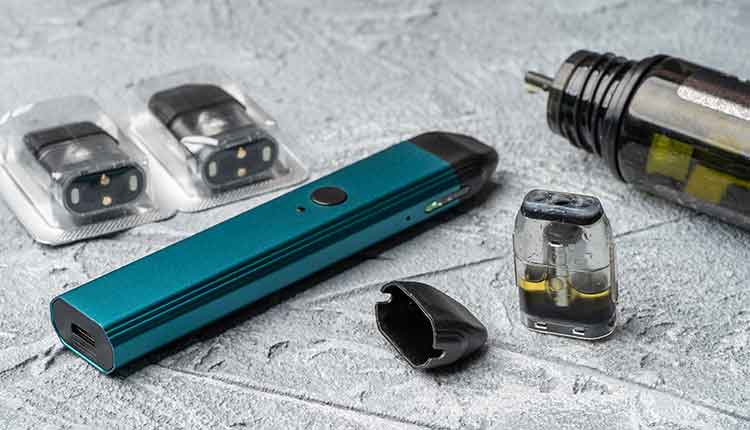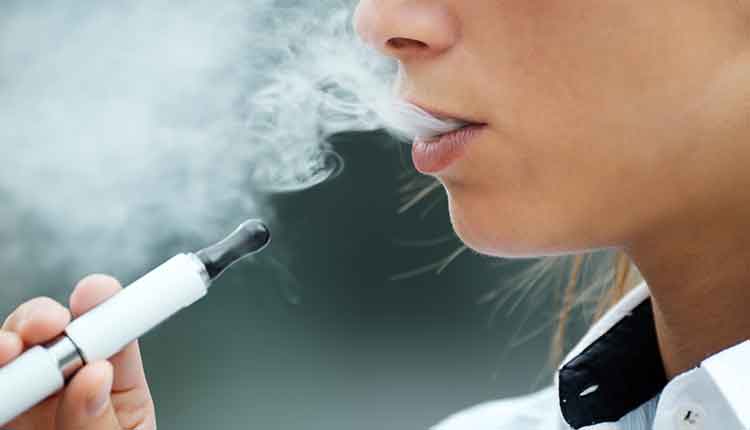
Dental caries is a complex, multifactorial disease with many etiologic factors, including diet, composition of oral bacteria, level of salivary flow, immune system and host response, effectiveness of oral hygiene regimen, presence of community water fluoridation, fluoride exposure, and access to dental care. Electronic cigarette (e-cigarette) ingredients and properties may also create an oral environment more conducive to caries.
Photo Credit: GoodLifeStudio / E+

Introduction of E-Cigarettes
E-cigarettes were first introduced in the early 2000s to deliver nicotine without tobacco combustion. In 2014, the United States Food and Drug Administration (FDA) labeled e-cigarettes a tobacco product, as they contain nicotine derived from tobacco plants. In 2016, the FDA began regulating all tobacco products, including electronic nicotine delivery systems (ENDS). While the FDA regulates the manufacture, import, packaging, labeling, advertising, promotion, sale, and distribution of ENDS, there are no FDA-approved ENDS currently on the market.
Photo Credit: property of Naveen Asaithambi / iStock / Getty Images Plus

Risks of Flavoring Chemicals
The flavoring chemicals used in ENDS, such as diacetyl and acetyl propionyl, can cause “popcorn lung” or bronchiolitis obliterans. In vitro research found that chocolate and cinnamon flavors in ENDS produced cytotoxic effects, oxidative stress, and inflammation. Many ENDS manufacturers note that the flavoring chemicals used are “food grade” and “generally recognized as safe” (GRAS). However, the GRAS certification provided by the Flavor Extracts Manufacturers Association pertains only to ingestion, not inhalation. Also, amid a drastic rise in ENDS use by adolescents who are often attracted by flavors, the FDA prohibited the manufacture and distribution of ENDS products with flavors, such as fruit and mint, that appeal to children in January 2020. However, this policy does not apply to the sale of flavors for tank-based systems.
Photo Credit: DedMityay / iStock / Getty Images Plus

Nicotine and Caries Risk
Research shows that nicotine exposure via traditional smoking increases caries risk. Nicotine enhances Streptococcus mutans biofilm metabolic activity and formation. When comparing current smokers to nonsmokers in Japan, Ojima et al found that smokers had significantly increased need for restorative treatment than nonsmokers. Another study of truck drivers discovered that the number of carious lesions present increased compared to how many cigarettes were smoked each day. However, similar research has yet to be conducted on the relationship between e-cigarette use. Exposure to nicotine may also cause swelling and inflammation of the palatal minor salivary glands; however, the clinical significance of this finding remains to be confirmed.
Photo Credit: Phoenixns / iStock / Getty Images Plus

Aerosol Danger
The aerosols generated by e-liquids are likely to adhere to any exposed hard or soft surface, including those of the oral cavity. This is due to the viscous nature of e-liquids and their glycerin base. As the ability of cariogenic bacteria to adhere to surfaces and form biofilm is influenced by surface roughness, the viscousness of e-cigarette aerosols may change surface characteristics, making the oral cavity more conducive to dental caries. Kim et al evaluated the impact of e-cigarette liquid ingredients—sucralose, ethyl butyrate, triacetin, and hexyl acetate—in the presence of S. mutans, and found they significantly increased biofilm formation, compared with an unflavored e-liquid control. Study authors suggest that esters, such as the ones in e-liquid flavors, provide a supplementary food source for S. mutans in oral biofilm. Additionally, they surmise that S. mutans attach to the aerosol-exposed surface and metabolize the base and flavors of the e-liquid to form a biofilm that demineralizes the enamel surface. As these data are preliminary, more research on the subject is necessary.
Photo Credit: diego_cervo / iStock / Getty Images Plus

Caries Risk
Caries risk assessment is essential for all patients, including e-cigarette users. Patients’ risk levels are determined by evaluating disease indicators, risk factors, and preventive factors via a caries risk assessment form. After determining whether a patient is low, moderate, or high risk, lifestyle is discussed and minimally invasive therapies, such as fluoride, antimicrobials, and calcium phosphate products, are recommended. If a patient indicates on the health history that they are using e-cigarettes, especially those with sweet flavors, clinicians should inform him or her that this is a potential risk factor for caries and suggest caries-mitigating strategies.

